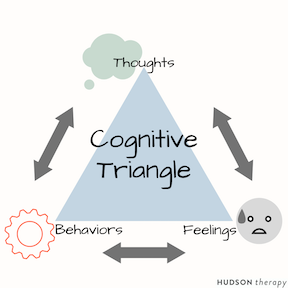3 Steps to Help Control Unproductive Thoughts with CBT
What is CBT?
CBT is an acronym that stands for Cognitive Behavior Therapy. CBT is an evidence- based treatment modality used in psychotherapy to assist people in identifying harmful or unproductive thought patterns. CBT has proven efficacious in treating anxiety, depression, addiction, OCD and myriad of other mental health conditions. Generally, CBT helps us highlight the impact our thoughts may have on how we feel day to day, and in turn, how we behave.
How many times have we heard the following after a triggering event:
“I can’t help it, it’s just how I feel” OR “That’s just how my brain works”
Accepting our thoughts as facts is not always helpful. These blanket, all or nothing statements are prime examples of narratives we tell ourselves with little to no evidence, robbing ourselves of our autonomy. Hopeful fact-we actually do possess the ability to change our deepest, most ingrained thought processes. Consider neuroplasticity; the idea that we are not all doomed to repeat the same mistakes and unproductive thoughts over and over again due to our biological wiring. Neuroplasticity teaches us that we can work to reframe our unproductive thoughts with self love and evidence and literally create new brain waves. You read that correctly, according to the National Institute of Health,“Neuroplasticity, is the ability of neural networks in the brain to change through growth and reorganization. It is when the brain is rewired to function in some way that differs from how it previously functioned to achieve a favorable result.”
3 Steps to Help Control Unproductive Thoughts with CBT:
Step 1: Identify Your Intrusive, Unproductive Thought
Examples: “I have let everyone down.” “ I was hurt before in my relationship, I can never trust again”, “I made a mistake. I can’t do anything right.” “I will never get through this.” “I had a bad day. My life is bad.” “Other people are so much happier than I am” etc.
Step 2: Ask Yourself, “What emotions does this thought evoke for me?”
Examples: Less than, belittled, insecure, upset, sad, envious, depressed, frustrated, etc.
Step 3: Reflect about how these feelings might be affecting your behavior
Examples: Isolate self, decrease in self esteem, lower baseline mood, increased irritability, etc.
Next Steps:
Now that you have identified your unproductive thought and teased out how it makes you feel and how it affects your behavior, ask yourself one simple question:
“Is the thought working for me?”
(To be clear: not if the thought was valid. The question is: is the thought a PRODUCTIVE one? )
If your answer is no, it may be time to reframe this thought.
Consider steps 1-3, (Thoughts, Feelings, and Behaviors) this time, I challenge you to replace your initial thought with one that doesn’t hold the same emotional response. Perhaps one with more facts, evidence and a drop of self care. “I am human, and I am allowed to make mistakes. None of my friends said anything to indicate I let them down.” How might your new replacement thought make you feel instead? Perhaps slightly less anxious, relieved, reassured. If you’re feeling slightly more calm and confident, how might that affect your behavior that day? Possible increase in confidence, and improved self esteem. BOOM. You rewrote your script for that day. Way to go. Your brainwaves are starting to reroute, and now you are statistically less likely to go back to old patterns of thinking. You now have a choice between two wavelengths, and one holds an outcome with brighter incentives.
Validation time: Why cognitive reframing takes time
In my experience, most people have really good reasons for why they are the way that they are. You likely have many excellent reasons why you don’t trust others for example. Maybe your loved one was not safe or dependable, you survived a traumatic event, someone made you feel small or worthless, etc. The point of CBT is not to invalidate your inner thoughts. It’s quite the opposite, to validate your emotional reaction, while holding space for logic. The aim is to find a more nuanced and realistic thought as you unlearn your unproductive ones and help you arrive at a healthier outcome. The first step to an effective reframe is to validate yourself for having the thought in the first place. For example, “ It makes sense that I would have a hard time trusting. I am working towards pursuing relationships that show me I am safe.”
What I find myself sharing over and over with my clients as we learn CBT skills is, “Yes, your feelings are valid. No, you don’t deserve to sit with the feelings and behaviors the thought is causing you.” Let’s move towards accepting your past as a lesson not a life sentence. You are in charge!
Start Small
If you are overwhelmed and don’t know where to start, I challenge you to be mindful of the thoughts that pop into your brain this week. As an experiment, keep a log and jot down the gist of your thoughts on a given day. At the end of the week, take stock. Even though you may understand why you are having these thoughts, and acknowledge they are valid, I want you to ask yourself, are my thoughts working for me? Do these thoughts aid me in being my best self? Do they build me up or tear me down? Do they motivate me or hinder my potential?
If you need help rewiring your thoughts, give us a call. We’d love to gently guide you through cognitive challenging techniques to reframe your thoughts into more productive, self loving and evidence- based statements. With all of the chaos in the world today, you deserve to like what you hear inside your mind.
References:
American Psychological Association, “What Is Cognitive Behavioral Therapy?”, APA Div. 12 (Society of Clinical Psychology)
National Institute of Health, “Neuroplasticity”, Matt Puderbaugh; Prabhu D. Emmady
The Hudson Therapy Group, The Cognitive Triangle (Image)


